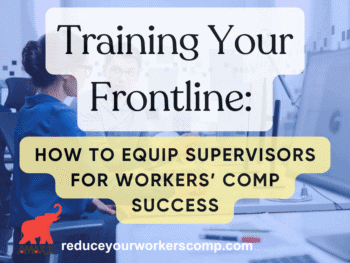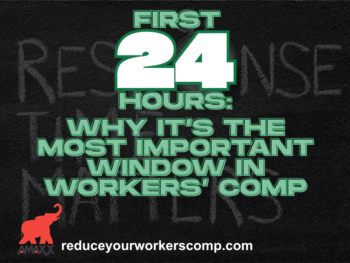Making a Habit of Return-to-Work
Twenty years ago, Stephen Covey published what's now an enormously popular book, The Seven Habits of Highly Effective People by Stephen Covey. More than 15 million copies of The Seven Habits have been sold in roughly 40 languages.
Before you write off Covey's book as just more self-improvement hoopla, consider this: You can use the seven habits to build a highly effective return-to-work process. Ultimately, you can reduce your claim costs and improve your productivity.
Habits One and Two: Lay the Groundwork
You will work with your employees to develop your return-to-work process. But first, you will lay the groundwork on your own.
Habit one teaches you to be proactive. Proactive people believe they are a product of their choices, not their circumstances. You should not accept injuries as a cost of doing business. You should choose to invest the time and resources to develop a return-to-work process.
The goal of your process will be to help injured workers get well and back on the job.
In habit two, you learn to begin with the end in mind. Write a policy statement that confirms your commitment to the return-to-work process. Your policy should stress the importance of operating safely and getting immediate medical care for injured workers. It should also explain that the company will work with injured employees to help them recover and return to the job, either at full or modified duty, as soon as medically appropriate.
"A good return-to-work process eliminates surprises," said Pat Crawford, return-to-work education coordinator at the Texas Department of Insurance's Division of Workers' Compensation.
"Everyone should know what to expect if they get injured on the job. We encourage employers to post their return-to-work policy in high-traffic areas and give every employee a copy," Crawford said.
Habits Three Through Six: Build the Process
Now you're ready to team up with your employees to build your process.
Habit three teaches you to start by putting "big rocks" first. Big rocks are things that are important for your long-term success. A task analysis is one of the biggest rocks in a return-to-work process.
Work with your employees to identify the activities involved in their jobs. Document the postures, lifting and carrying requirements, actions and motions, equipment and environmental conditions. Then, identify alternative work that meets the employee's restrictions as specified by the doctor.
"We're not talking about busy work," Crawford said. "Alternative work should be meaningful, and it should contribute to productivity. Research shows that injured workers who get back on the job in some capacity actually recover faster."
Crawford's advice makes for a smooth transition into habit four, when we learn to think win-win. Return-to-work is a clear win-win for you and your workforce. You win by reducing lost productivity, workers' compensation benefits and other costs of workplace accidents. Your employees win by getting well and remaining productive members of the workforce.
You can promote the recovery process by simply staying in touch with your injured workers. In fact, communication drives the entire return-to-work process.
Before you can communicate effectively, however, you must master habit five: Seek first to understand, and then to be understood.
Call injured employees regularly while they are recovering away from the workplace. Ask them whether they have questions about the return-to-work process. Find out whether they need help with their recovery. By showing that you care about injured employees, you keep them connected to the workforce.
That sense of connection sets your company up for success in habit six, when you learn to synergize. Synergy means working together to find a better way to do something.
Get your employees' input as you develop and carry out your return-to-work process. Ask them to help you identify the hazards of their jobs, redesign tasks, write job descriptions and identify alternative productive work. Employees who feel a sense of ownership over the return-to-work process are more likely to embrace it.
Habit Seven: Keep it fresh
You now have a solid return-to-work process, complete with employee buy-in. You're on your way to controlling your claim costs and improving your productivity. But don't stop there. Your process needs regular attention if you want to keep it fresh. (workersxzcompxzkit)
Habit seven is the habit of renewal and continuous improvement. Treat your return-to-work process as a work in progress. Employees will come and go, and job tasks will change. Work closely with your employees to regularly review your process and make sure it fits your operations.
Author: Sally McGraw is leader of the Catastrophic Injury Team at Texas Mutual Insurance Co., the largest provider of workers' compensation insurance in Texas. (800) 859-5995. Email: information@texasmutual.com.
Try Our FREE WC Best Practices Quick Check: http://www.workerscompkit.com/intro/ Books & Guides: http://www.reduceyourworkerscomp.com/workers-comp-books-manuals.php TD Calculator:www.ReduceYourWorkersComp.com/transitional-duty-cost-calculator.php Do not use this information without independent verification. All state laws vary.
©2008 Amaxx Risk Solutions, Inc. All rights reserved under International Copyright Law. If you would like permission to reprint this material, contact Info@WorkersCompKit.com
















